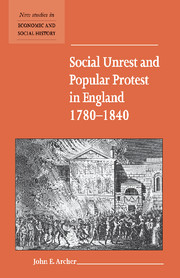Book contents
1 - Introduction: historiography, sources and methods
Published online by Cambridge University Press: 05 July 2015
Summary
The study of popular protest and social unrest has burgeoned since the 1960s. Before then only a handful of historians had shown any inclination either for rescuing the masses as historical actors in their own right, or for allowing acts of protest any historical significance or importance. ‘High politics’ with the mob playing a subsidiary walk-on role had, until then, dominated historical writing. There were exceptions, such as the Hammonds (1920), Darvall (1936) and Wearmouth (1945). Their work, however, failed to establish the sub-genre of social history which the study of protest was to become. The belief that protest in the form of riots and social movements has much to tell us of society, particularly of the masses who normally left little historical record, was championed by a triumvirate of British marxist social historians: George Rudé, E. P. Thompson and Eric Hobsbawm. Possessing the same motivation for writing ‘history from below’ and rescuing, in the now-famous phrase of Thompson, ‘the poor stockinger, the Luddite cropper, the “obsolete” hand-loom weaver, the “utopian” artisan, and even the deluded follower of Joanna Southcott, from the enormous condescension of posterity’ (1968: 13), these three historians made distinctive but complementary contributions to our understanding of popular protest. In the process they generated a continuing interest from a new generation of researchers and scholars.
Rudé has been credited with identifying the ‘faces in the crowd’, as has Hobsbawm for the phrase and the concept of ‘bargaining by riot’, whilst Thompson is remembered both for his ‘making of the working class’ thesis and for the influential ‘moral economy’ concept, which was originally attached to food rioting but has since been developed and deployed in the interpretation of many other protest gatherings. What these three, and subsequent historians, have been doing is trying to answer what appear to be simple questions: namely the ‘who’, ‘what’, ‘when’, ‘where’, ‘why’ and ‘how’ of protest. Such questions have produced answers which have led both to serious academic debate and disagreement, and to complex and sophisticated analysis and methodology. Consequently, historians now specialise in increasingly narrow fields of protest study. The one major exception is John Stevenson, whose work Popular Disturbances in England 1700–1832 (1992) provides the fullest synthesis of protest in all its forms.
- Type
- Chapter
- Information
- Publisher: Cambridge University PressPrint publication year: 2000

